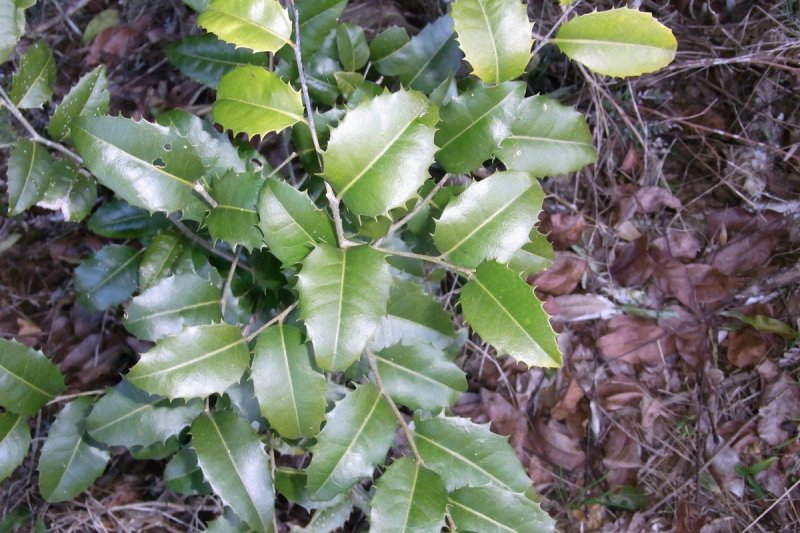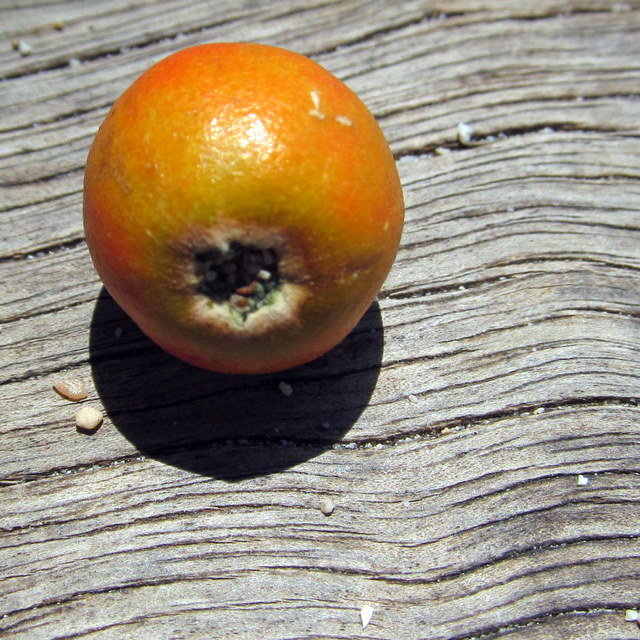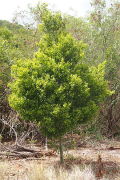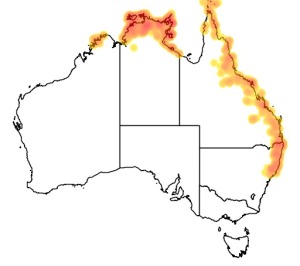Colours
Distinguishing features
The leaves are elliptical, ovate to ovate-oblong in shape, 4 to 9 cm long and 1 to 5 cm wide. They are wavy edged, stiff and thick. The margins are toothed, without teeth or with scalloped margins.
The leaves are abruptly tapered at the base, with a leaf tip or rounded at the end. They are hairless and glossy green, somewhat paler green underneath.
Leaf stems are 3 to 6 mm long.
Juvenile leaves are prominently toothed. Leaf veins are easily noticed, raised on both sides of the leaf. There are five to seven lateral veins, at around 65 degrees to the midrib.
Yellow brown flowers form in November, from the forks of the leaves. Male and female flowers are on separate trees. Individual flowers are around 4 mm in diameter. Male flowers in axillary racemes with a perianth around 2 mm long, with 5 to 10 stamens. Female flowers are solitary or in clusters of 3 or 4.
The fruit is a bright red drupe, 12 to 20 mm long with moist yellow flesh inside. The single seed is about 12 mm long, oval in shape with a groove on one side. Fruit mature from February to April. (Wikipedia)
Size
- Up to 2500 cm (Height)
- Up to 60 cm (Trunk width)
Synonyms
Comments
Guardian:Noah Shaw
by David Witherall
Distribution
Distribution and habitat preferences
It occurs as far south as the Hunter River, New South Wales, and north to Torres Strait. It also is occurring inland at the Bunya Mountains in south eastern Queensland, Northern Territory and Western Australia. The subspecies affinis is endemic to Lord Howe Island.
The habitat varies, but it is often found in monsoon forest, drier rainforest, as well as littoral rainforest, and rainforest by streams. (Wikipedia)
Web resources
Natural predators
- Animalia: Emerald Dove (species: Chalcophaps indica) (Eat the fruit.)
- Animalia: Wompoo Fruit-dove (species: Ptilinopus (Ptilinopus) magnificus) (Eat the fruit.)
- Animalia: Topknot Pigeon (species: Lopholaimus antarcticus) (Eat the fruit.)
References
- Byrnes, N.B., S.L. Everist, S.T. Reynolds, A. Specht and R.L. Specht (1977). The vegetation of Lizard Island, North Queensland, Proceedings of the Royal Society of Queensland, 88: 1-15. LIRS catalog number 3.
- De Sloover, J.R. and M. Dufre^ne (1999). Flora and vegetation of Turtell V, Turtell Islands Group (Queensland, Australia), Bull. Jard. Bot. Nat. Belg./ Bull. Nat. Plantentuin Belg., 67: 45-97. LIRS catalog number 577.
- De Sloover, J.R. and A.-L. Jacquemart (2008). Nymph Island (Great Barrier Reef, Qld., Australia): Flora and vegetation of a low wooded island, Scripta Botanica Belgica, 43: 1-88. LIRS catalog number 1210.
- View all references










